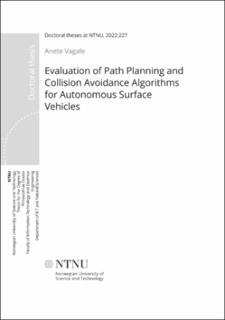| dc.contributor.advisor | Bye, Robin T. | |
| dc.contributor.advisor | Osen, Ottar L. | |
| dc.contributor.advisor | Fossen., Thor I. | |
| dc.contributor.author | Vagale, Anete | |
| dc.date.accessioned | 2022-10-05T08:06:35Z | |
| dc.date.available | 2022-10-05T08:06:35Z | |
| dc.date.issued | 2022 | |
| dc.identifier.isbn | 978-82-326-5313-3 | |
| dc.identifier.issn | 2703-8084 | |
| dc.identifier.uri | https://hdl.handle.net/11250/3023890 | |
| dc.description.abstract | Recently, there has been an increased focus on developing an autonomous shipping technology that is safe, trustworthy, and efficient. Some enablers of this technology are strategies to advance sustainability and reducing CO2 emissions. This is achieved by making ships more efficient, increasing safety and reducing the number of accidents caused by human errors on water, and reducing operational costs. However, there are still many challenges to face before autonomous technology on the water becomes a part of our daily life.
A safe and reliable path planning and collision avoidance method is an important component in autonomous shipping and plays a key role in incorporating this technology into our daily lives. Although numerous path planning algorithms for autonomous vessels have been developed, each with its own benefits and limitation, there is no one ultimate path planning and collision avoidance algorithm that is suitable for every vessel, in all water regions and in all scenarios. There is also no unified way of evaluating and comparing these algorithms to find the most suitable one for the chosen use case.
In this context, the main purpose of this research is to propose a strategy for a unified evaluation and comparison of path planning and collision avoidance algorithms. To achieve this goal, it is essential to first gain an understanding of path planning and collision avoidance as a part of the autonomous surface vehicle’s guidance, navigation, and control system. There are two main application cases. First, it could be used as an offline benchmarking tool to evaluate and compare the algorithms. Second, it could be used online on an actual vessel to select the safest and most efficient path in the planning phase based on the current situation.
This thesis presents an evaluation simulator platform (ESP) for evaluating path planning and collision avoidance algorithm performance for autonomous surface vehicles. In particular, the work focuses on an extended collision risk assessment (ECRA) method for evaluating the generated paths from a safety perspective. The testing results indicate that the proposed approach could be used for autonomous path planning and collision avoidance algorithm evaluation and comparison with some improvements. | en_US |
| dc.language.iso | eng | en_US |
| dc.publisher | NTNU | en_US |
| dc.relation.ispartofseries | Doctoral theses at NTNU;2022:227 | |
| dc.relation.haspart | Paper 1: Vagale, Anete; Oucheikh, Rachid; Bye, Robin Trulssen; Osen, Ottar Laurits; Fossen, Thor I.. Path planning and collision avoidance for autonomous surface vehicles I: a review. Journal of Marine Science and Technology 2021 https://doi.org/10.1007/s00773-020-00787-6 This article is published under an open access license | en_US |
| dc.relation.haspart | Paper 2: Vagale, Anete; Bye, Robin Trulssen; Oucheikh, Rachid; Osen, Ottar; Fossen, Thor I.. Path planning and collision avoidance for autonomous surface vehicles II: a comparative study of algorithms. Journal of Marine Science and Technology 2021 https://doi.org/10.1007/s00773-020-00790-x This article is published under an open access license (CC BY 4.0) | en_US |
| dc.relation.haspart | Paper 3: Vagale, Anete; Bye, Robin Trulssen; Osen, Ottar. Evaluation of Path Planning Algorithms of Autonomous Surface Vehicles Based on Safety and Collision Risk Assessment. MTS/IEEE Global OCEANS conference 2020 https://doi.org/10.1109/IEEECONF38699.2020.9389481
- © 2020 IEEE. Personal use of this material is permitted. Permission from IEEE must be obtained for all other uses, in any current or future media, including reprinting/republishing this material for advertising or promotional purposes, creating new collective works, for resale or redistribution to servers or lists, or reuse of any copyrighted component of this work in other works | en_US |
| dc.relation.haspart | Paper 4: Vagale, Anete.
Evaluation Simulator Platform for Extended Collision Risk of Autonomous Surface Vehicles. Journal of Marine Science and Engineering 2022 ;Volum 10.(5)
https://doi.org/10.3390/jmse10050705
This is an open access article distributed under the Creative Commons Attribution License (CC BY 4.0) | en_US |
| dc.relation.haspart | Paper 5: Vagale, Anete; Osen, Ottar; Brandsæter, Andreas; Tannum, Marius Stian; Hovden, Christian; Bye, Robin Trulssen. On the use of maritime training simulators with humans in the loop for understanding and evaluating algorithms for autonomous vessels. The 4th International Conference on Maritime Autonomous Surface Ships (ICMASS) 2022 https://doi.org/10.1088/1742-6596/2311/1/012026 Content from this work may be used under the terms of the Creative Commons Attribution 3.0 licence. (CC BY 3.0) | en_US |
| dc.title | Evaluation of Path Planning and Collision Avoidance Algorithms for Autonomous Surface Vehicles | en_US |
| dc.type | Doctoral thesis | en_US |
| dc.subject.nsi | VDP::Technology: 500::Information and communication technology: 550 | en_US |
| dc.description.localcode | In reference to IEEE copyrighted material which is used with permission in this thesis, the IEEE does not endorse any of NTNU’s products or services. Internal or personal use of this material is permitted. If interested in reprinting/republishing IEEE copyrighted material for advertising or promotional purposes or for creating new collective works for resale or redistribution, please go to http://www.ieee.org/publications_standards/publications/rights/rights_link.html to learn how to obtain a License from RightsLink. | |
